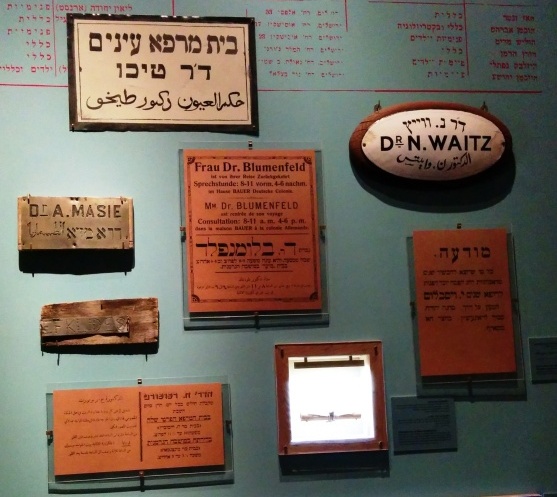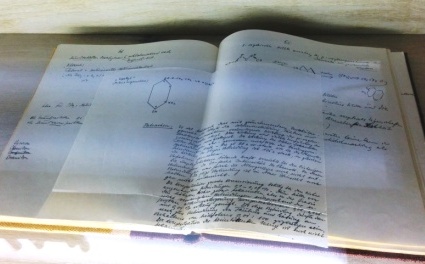A special exhibition entitled “Jerusalem: A Medical Diagnosis” is currently on display at the Museum of the History of Jerusalem, at the Tower of David. The exhibition tells the history of medicine in Jerusalem from the biblical era to the 20th century. The exhibition is composed of documents and unique items taken from a variety of archives and collections of individuals that were transferred to the Tower of David for display. The CZA, too, contributed items that were displayed.
 The exhibition begins by displaying diseases and pharmaceuticals that appear in the Bible. It touches on the situation in the Middle Ages and continues into modern times. In the early 19th century Jerusalem was a neglected city. Its residents lived crowded within the Old City walls, which increased the dirt in the streets. Diseases spread rapidly, causing many deaths. Healers cured patients using charms and potions. The need for modern medicine was clear, and beginning in the 1830’s, clinics, hospitals and pharmacies began to be set up, one after another. At first, medical institutions were concentrated within the City walls, but at some point - due to lack of space - the institutions began moving outside the walls. The documentation at the CZA begins at this period and accompanies the transformation of Jerusalem from a medieval city into a modern one.
The exhibition begins by displaying diseases and pharmaceuticals that appear in the Bible. It touches on the situation in the Middle Ages and continues into modern times. In the early 19th century Jerusalem was a neglected city. Its residents lived crowded within the Old City walls, which increased the dirt in the streets. Diseases spread rapidly, causing many deaths. Healers cured patients using charms and potions. The need for modern medicine was clear, and beginning in the 1830’s, clinics, hospitals and pharmacies began to be set up, one after another. At first, medical institutions were concentrated within the City walls, but at some point - due to lack of space - the institutions began moving outside the walls. The documentation at the CZA begins at this period and accompanies the transformation of Jerusalem from a medieval city into a modern one.
The CZA holds documentation about the medicine on Jerusalem in various collections. Institutional archives such as “Hadassah” contain much information on the subject. The Photograph Collection has many photographs of various hospitals which were established in Jerusalem, and of the medical staff at work in these hospitals.
 Items from the CZA shown at the exhibition, are from the private papers of Moshe Wallach and Gunther Friedlander, and the papers of the Hadassah Organization. Dr. Moshe Wallach founded the Shaare Zadek Medical Center in 1901. He was strictly religious and kept the Sabbath, even at the hospital, which evoked much anger among the residents. The CZA transferred Wallach’s personal tzitzit for display. Doctor Gunther Friedlander is a less well-known personality. He founded a pharmacy called “Teva” in the Bait Vegan neighborhood in the years 1934-1935. After the State of Israel was established, the pharmacies “Assia” and “Zori” merged with “Teva” and founded the well-known “Teva Pharmaceutical Industries”. The CZA transferred Friedlander's notebook, containing formulas for various drugs sold at his pharmacy. Hadassah’s archive is also represented in the exhibition: a handbill with instructions on how to prevent diseases at the beginning of the New Year is displayed in the exhibition.
Items from the CZA shown at the exhibition, are from the private papers of Moshe Wallach and Gunther Friedlander, and the papers of the Hadassah Organization. Dr. Moshe Wallach founded the Shaare Zadek Medical Center in 1901. He was strictly religious and kept the Sabbath, even at the hospital, which evoked much anger among the residents. The CZA transferred Wallach’s personal tzitzit for display. Doctor Gunther Friedlander is a less well-known personality. He founded a pharmacy called “Teva” in the Bait Vegan neighborhood in the years 1934-1935. After the State of Israel was established, the pharmacies “Assia” and “Zori” merged with “Teva” and founded the well-known “Teva Pharmaceutical Industries”. The CZA transferred Friedlander's notebook, containing formulas for various drugs sold at his pharmacy. Hadassah’s archive is also represented in the exhibition: a handbill with instructions on how to prevent diseases at the beginning of the New Year is displayed in the exhibition.